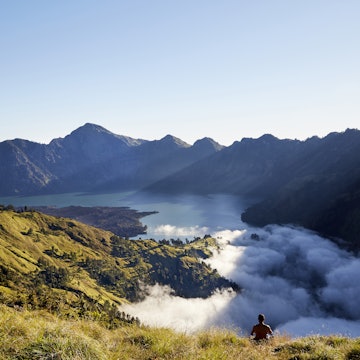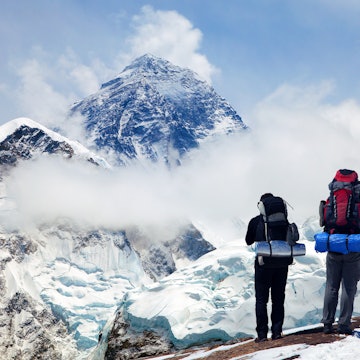
There’s method in the madness: tips for becoming a pro packer
Jul 28, 2016 • 5 min read

Packing is a necessary evil that all travellers must endure, and when it comes to doing it well, few of us are walking away with any prizes. So whether you’re typically stuck straddling a bulging suitcase, or are simply on the hunt for a few tips to top up the knowledge bank, become a master of the art with this assortment of packing methods from our new book, How to Pack for Any Trip.

Method: rolling
Join the jet set. Regular travellers swear by the rolling method for its space-saving, crease-free advantages.
For coats, jackets, T-shirts, jumpers, shirts, blouses, dresses:
Step 1: Hold up the garment with the front facing you, then pinch the shoulders halfway along between your thumb and forefinger, bringing your other fingers to the front. If the garment has a hood, flip it back.
Step 2: Twist your wrists inwards to turn the sleeves to the back, bringing the outer edges of the sleeves to touch each other.
Step 3: Lay the garment on a flat surface front down and fold in half, bringing the neck down to the base of the garment.
Step 4: Tidy into a neat rectangle.
Step 5: Tightly roll up the garment.
For trousers, shorts, tube dresses, straight skirts fold in half – following the tailoring – and tightly roll the garment to the hem.
Pro - Saves space, avoids creases.
Con - Technique needs mastering for speed. Must fully unpack at destination.

Method: Tetris-style
One for gamer geeks, this technique turns packing into a puzzle. Combine blocks of different shapes and sizes to form complete rows. Stack your rolled and/or folded clothes vertically or horizontally; there’s no need to stick to one plane in this game. Beware, this method only really works if you can unpack fully at your destination – not recommended for backpackers on the move.
Pro - Ultimate space-saver. Good for families – making a chore into a game.
Con - Need to be good at puzzles. The whole system is just one removal of an ill-placed item away from falling apart.

Method: folding
Probably the most popular way to pack, yet the folding method is criticised for an origami-style approach that keeps the travel-iron manufacturers in business.
For coats, jackets, T-shirts, jumpers, shirts, blouses, dresses:
Step 1: Hold up the garment with the front facing you, then pinch the shoulders between your thumb and forefinger, with your other fingers at the front. If the garment has a hood, flip it back.
Step 2: Twist your wrists inwards to turn the sleeves to the back, bringing the outer edges of the sleeves to touch each other.
Step 3: Lay the garment on a flat surface front down and fold in half, bringing the neck down to the base of the garment.
Step 4: Tidy into a neat rectangle.
Step 5: Fold again as desired.
For trousers, shorts, tube dresses, straight skirts fold the garment in half vertically – following the tailoring – and continue to fold until the desired size is achieved.
Pro - Mobile chest of drawers – no need to fully unpack at destination.
Con - Creases. Less space-saving than rolling.

Method: bottom-heavy
However you pack, always keep heavy items such as shoes, toiletries, electronics and books at the bottom of your luggage. This gravity-friendly tactic will help reduce creases, too. But think accessibility – your coat may be heavy, but you should still pack it at the top, especially if headed to a destination where the weather is unreliable.
Pro - Stops your case or bag falling on the person in front in the check-in queue – and won’t be top-heavy when you’re in motion. Helps reduce wrinkles.
Con - Backpackers may have accessibility issues.

Method: bundling
As seen on YouTube. You may feel you’ve better things to do with your time than perfect such wizardry.
Step 1: Lay a jacket flat on a table with its collar down and arms out.
Step 2: Lay a long-sleeved shirt on the jacket at 180 degrees, collar up, arms out. Position the top of the shirt collar about halfway down the jacket. This is where you’ll later create a core around which the bundle will fold.
Step 3: Going from most-tailored to least-tailored layer your garment in alternating directions over the outline of the original garments.
Step 4: Fold trousers and shorts in half vertically and line them up down the seams of the shirt arms, again, alternate direction.
Step 5: Continue to build the bundle.
Step 6: Put underwear between the collars to create the core. Wrap the first T-shirt around the items, sleeves first, body second. Continue to wrap all the clothes in the same manner around the core, smoothing out the fabric as you go until you have one big bundle.
Pro - Fewer creases than folding.
Con - Some items will be inaccessible until you fully unpack. Requires you to be strategic about space for other items, such as a toiletry bag.

Method: stuffing
If you’re the kind of traveller who likes to leave everything to the last minute, stuffing is for you. Chaos rather than method is invoked. Fast, furious – and possibly the worst way to pack.
Step 1: This method occupies a place beyond rules. Anything goes.
Pro - Works for all types of bag. You don’t need to engage brain (can be done with a hangover/jet lag).
Con - Creases. Bad use of space. Guaranteed inaccessibility. Potential time wasted sitting on bag to get it to shut.

Method: creating compartments
The Russian-doll approach to packing is great for the (over-)organised traveller.
Buy pods and bags that allow you to pack items separately at stores such as Muji and Ikea, or choose lightweight expandable packing cubes, which are available from good department stores. Consider colour coordination for quick identification of items. Look out for bespoke packing solutions, too, such as bra cases, jewellery rolls and shoe bags.
Alternatively, save money by creating your own compartments: a large make-up bag could hold your delicates; resealable kitchen bags are useful for small items such as cables and plugs; plastic film-roll canisters and old glasses cases are ideal for protecting jewellery and storing coins/foreign currency.
Pro - Easily accessible.
Con - Could be expensive. Space is wasted on the containers themselves and they potentially add weight.
Unpack even more methods from Lonely Planet’s How to Pack for Any Trip book or take our quiz to find out if your packing prowess makes the grade.













